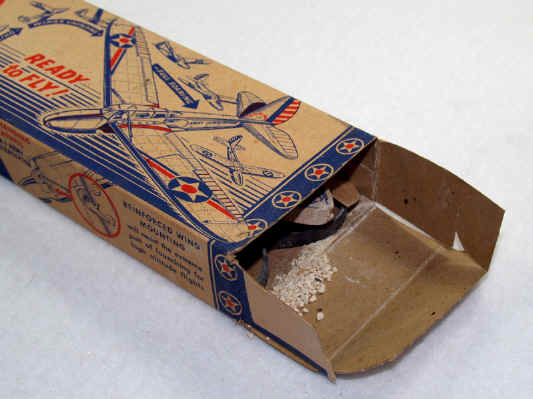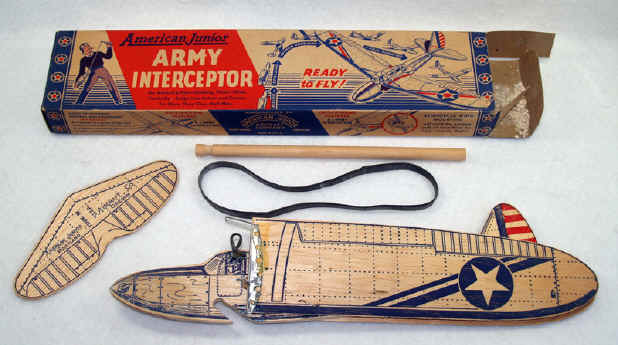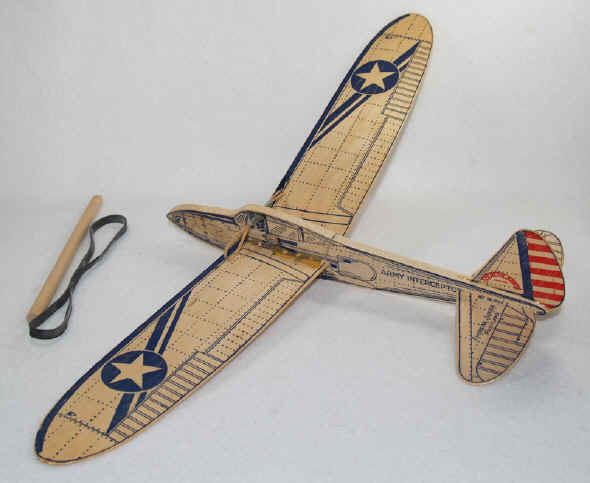All About Old Toys
|
|
AJ
Army Interceptor
“Time Capsule”
Article by
Dave Pecota
|
AJ Army Interceptor “Time Capsule” As we all know, collecting vintage items of any sort is a test of perseverance and patience. Occasionally, you may be rewarded by having a chance to “turn back the clock” and add a vintage item to your collection that literally has not seen the light of day since it was first packaged. I had just such an opportunity recently. I purchased an American Junior “Army Interceptor” folding wing glider … the type used by US Army soldiers during WW2 for gunnery practice … in its original box. Reportedly, the box had never been opened since leaving the AJ factory during WW2. The original owner was a Lockheed employee and an avid model airplane builder. This gentleman had many airplane kits that he never had a chance to build or fly before his time in this world was over. Several unopened 1940’s era kits along with other vintage items were placed into storage in 1981. In 2010, his widow (now in her 90’s) decided it was time to “let go” of some of these items. I was fortunate to have a chance to add his AJ Army Interceptor to my collection. Since I may be opening this
vintage glider box for the first time since it left the factory over 65
years ago, I decided to document the event with photos.
Photo 2 shows the end flaps opened for the first time. Note the gravel-like material that started rolling out of the box. At first, I wasn’t certain what this material was. However, I immediately recognized the black rubber as the type used by AJ with its catapult launch sticks. And yes … I was relieved to see the nose of a glider peering out from inside the box. The box wasn’t just filled with a modeler’s wood scraps. (Something I had experienced before.)
Photo 3 shows the contents of the box after I slowly slid them onto my photo table. It was immediately clear that the glider was exactly what the box indicated it was … an original AJ Army Interceptor from WW2. Its “factory-fresh” condition seemed to confirm that it had never flown and possibly had never been removed from the box.
Although most pre-War Interceptors had colorful red & blue markings on the wing … many War-era versions came with the wings printed with a single color, all red or all blue. The company reportedly used the ink color most readily available at the time each batch of gliders was made. As with the US military, Jim Walker eliminated the red circle within the large star on the wings soon after the War began. This was done to avoid confusion with the Japanese “rising sun” markings. (Although the original box art was apparently never changed.) Further examination of this glider revealed that there was quite a bit of material missing from the cavity in the glider’s nose. There was also discoloration of the wood in this area on both sides of the glider. I deduced the “loose gravel” material was the remnants of the substance used to fill the cavity as a nose weight. Pre-War Interceptors had a ball bearing or flat piece of metal for a nose weight. The knowledgeable folks at American Junior Classics confirmed that Jim Walker often utilized a Barium paste for this purpose during the War, because of the metal shortages. The discoloration of the wood was undoubtedly due to the paste leaching into the wood over time. Although the thick rubber band used with catapult stick was still pliable, the small rubber band inserted into the metal tube over the “cockpit” in the fuselage was nearly petrified. It was also fused to the inner surface of the tube. Since this rubber is used to hold the wings in place when they are fully extended, I elected to replace it. I was able to use a small hand drill to bore into the rubber and then slide it out of the tube. Fresh, contemporary rubber was re-inserted. Now, all that was left to do was connect the fuselage rubber to the wing hooks, and slide in the horizontal stabilizer. The glider was now fully assembled ... maybe for the first time. Photo 4 is the glider’s “official portrait”. Although this entire process only took a few hours, for a short time I was back in the War-years of the 1940’s. Was I tempted to run outside and launch this beauty a couple times? You bet! But the “collector” in me has over-ruled the “kid” in me … at least for now.
|



